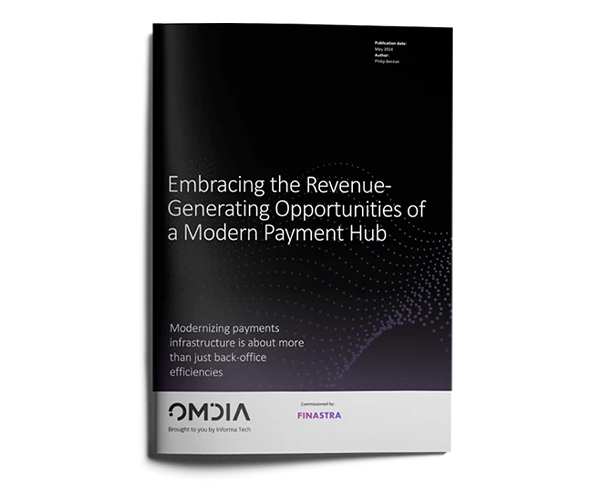Modern payment architecture: Key to emerging payment trends
The payments sector is evolving rapidly with, for example, the emergence of real-time payment rails, ISO 20022 adoption, cryptocurrencies, Generative AI applications, and modern messaging technologies. Financial institutions need a common approach to support payments innovation, with a shift occurring to central platforms that can support multiple payment types rather than siloed engines.
Find out more1Global spend on payment hubs is expected to grow at a CAGR of 9% to reach $3.1bn in 2027, compared with $2.0bn in 2022.
Alongside the changes in business architecture, financial institutions are reviewing the technical architecture changes needed to deliver operational efficiency, agility, scalability, and resilience.
A new report by Omdia highlights key architectural considerations that must be borne in mind when planning your modernization journey.
1.1The increasing global adoption of instant payments is a major area forcing the pace of payments modernization as their operational characteristics (24x7 availability, secure, resilient, fast, elastic, scalable) is an excellent example of the need to implement cloud-native technologies (e.g., microservices, containers, container orchestrators, and distributed data streaming) to enable financial institutions to deploy or onboard to a solution that is responsive, scalable, and fault tolerant.
The cost of not modernizing
Many banks are investing heavily in new technologies to drive their digital transformation despite the tough environmental outlook. From a technology perspective, cost management pressures will remain strong. While this has impacted overall technology spending (and will continue to), it is balanced to some extent by the role technology plays in increasing automation and customer self-service.
It’s not difficult to see how this arises. Tight delivery deadlines and budget constraints mean that meeting new compliance or regulatory changes, or supporting an enhancement of their existing services, is often achieved by patching their existing system, making sacrifices, taking shortcuts, or using workarounds. But such compromises mount up and cause technical debt within their payments infrastructure, hampering their ability not only to innovate and respond to the dynamic market requirements, but also efficiently operate and deliver payment services and accommodate volume increases. Financial institutions are realizing that with the frequency of changes that they now need to deal with they are at a tipping point.
The top priorities for payment infrastructure investment
Payment hubs with extensive features and functionality in-built are less of a factor for banks when deciding who to partner with. The agility, resiliency and flexibility of the platform, and the reliability of the vendor in supporting its customers being the most important criteria; a demonstrable track record of successful delivery and ongoing support is vital.
Essentials of modernization
The Omdia report identifies a number of key attributes of a modernized payment hub:
As new models such as Open Banking and Open Finance become the norm, payment solutions will need to transition to smaller, composable, microservices-based standalone components that can be easily integrated through APIs enabling co-innovation with the growing ecosystem of specialist fintech services.
Corporate banks have the appetite to embrace open banking; in Omdia’s IT Enterprise Insights (ITEI) 2024 survey:
4By adopting a modern payment hub solution, leveraging cloud-native technologies, DevOps practices and open architectures, banks can embrace change, drive innovation, and focus on service excellence.
Finastra’s payment hub solutions Global PAYplus and Payments To Go open the door to this new world of payments.
New report
Download the full report to understand the urgency behind payments modernization initiatives and why banks risk losing their competitive edge, or even their ability to operate in an increasingly regulated landscape, if modernization plans are delayed further. Understand where financial institutions are in their cloud-adoption journey and why they’re actively investing in modern payments technology to help them future-proof their payments business and deliver an open future of payments.

